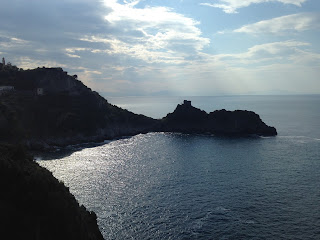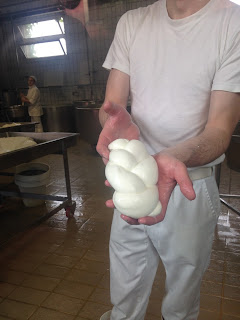Like a previous trip I have been extremely remiss in not staying current on these posts. However I did use that wonder App called
Track My Tour (please tell Chris that I sent you if you check it out) which did a much better job. Here is the link to this part of the trip --
Click here.
**
Today was a really interesting day, not only because of the brilliant tour we went on but also because of what we learned, heard and talked about during the day. Fortunately our driver and guide for the day, Umberto, was very garrulous but like Daniele the day before apologised profusely about his terrible English. Oh that my Italian was as terrible as his English.
It also made me wonder what accent we English have when we attempt to speak a foreign language. Do we all sound like Hugh Grant for example but in French or Italian? Most non-English speakers have an enchanting accent when they speak English, is ours enchanting? It feels terrible when I give it a go.
It rained on the way but the views were still great. We also managed to get to know Umberto a bit and his story was pretty typical, it seems to me. He is 30, married and still lives at home. Like many in Amalfi, he works in the tourist industry because there is nothing else. His degree and training were in shipping but that industry globally is in a mess so here it is. His wife is the same.
Work here is for 6 months each year and then for 3 months, maybe more if they can get it, both go to a ski resort in the Dolomites where they are waiters. He needs the money to live, he said. Both earn 1500 euros per month so buying a property is out of the question as nobody locally sells and the only people that buy are from outside or foreigners who have silly money to spend.
Tough life.
 |
| Salerno in the distance |
Where we were heading was over an hour away beyond Salerno and on the way down the coast. First was a buffalo mozzarella farm that we wanted to check out.
The tour was interesting even though the guide was very grumpy. Buffalo mozzarella is the premium brand as the milk is of a consistency and creaminess to make it that much better than regular mozzarella. I agree, it was lovely.
The buffalo themselves are really big and very docile. Curiously they pretty much take care of themselves which was quite startling.
When they wanted to be milked, they cheerfully took turns waiting to go into the milking machine. I watched fascinated as the machine was robot driven and each of the 4 milking tubes had an infra red light it used to find the udder. Once it found it, the tube simply rose up and fixed itself on all by itself. Once all were done, milking began. Once finished the process was reversed and the buffalo cheerily wandered off for a bite to eat.
Of course there's plenty of fertilizer for the gardens where they grow their own veggies and herbs for the top of the line restaurant located there.
Curiously they do not eat the meat. The Italians don't like it so it goes to dog and cat meat.
As for the mozzarella itself, most interesting. First of all the milk, swirl it around for a while until it starts to separate. Take the part that is the curds. Add some salt and a little water and leave it in a tub. Get 4 burly guys to squeeze it and mold it into interesting shapes.
The other weird thing is that they don't sell their produce to the public! So how do they earn money to keep the farm going, I asked. Tours like this (which cost 10 euros each!), the cafe and high priced restaurant (with only space for 30 covers) do the trick. Sounds very unlikely to me!
Next and best of all was Paestum just down the road.
What a place! This is where the first Greeks landed in the 6th century BC and where some of the best preserved temples and buildings from that time still exist. Reason for this is that by the 2nd century AD, this place was a backwater even for the Romans so nobody lived here and therefore nobody nicked the big rocks lying around for building materials for their homes. Also in the 4th century, a nearby river overflowed its banks and turned the entire area into a malarial swamp that deterred everyone, even the Barbarians, for the next 1200 years.
 |
| The Temple of Hera built in about 450 BC |
 |
| One thing that makes this temple so interesting is that the inner part still remains so you can see how the original temple was laid out. Also these buildings had stucco on top of the stonework which was painted. This was pink and light blue. I just can't imagine it today! |
The entire location is approximately round and about 5 kms in diameter. It is about 3 kms from the sea but back then was of course on the coast line. Back in the 1850's before excavations really began in earnest, a road was built pretty much through the middle of the site because they didn't know that some of the buried buildings were there. It was built by the then King of the Kingdom of the Two Sicilies (some Bourbon) who wanted a quicker way to get to the south. The land to the north of this road had no big temples on it so was sold off to private people while the land to the south had the big temples so was preserved. It is this part that has been excavated thoroughly according to our wonderful guide, Adele.
 |
| The swimming pool of the Temple of Vesta where all ladies congregated on one special day in the year for various ceremonies. Men were banned on pain of death. |
Again profusely apologetic for her pitiful English, she talked up a storm and how interesting it all was too. She'd grown up only 1 km from here so used to play around these big old buildings... and therefore had a natural interest along with a seemingly encyclopedic knowledge.
Interestingly this was also where the Allies landed in 1943, being pretty flat and deserted. The local mayor apparently begged the Americans not to bomb those big old buildings as they were about to which is why they are in such great condition today.
On the way back we somehow got into a conversation with Umberto about Garibaldi (or Gari-bloody-baldi according to Umberto). Unification was not the unalloyed joy that it has been made out to be. Pre-1860, Italy was divided into the small bits to the north that had nothing and were dirt poor, and the large southern kingdom which had been stable for 800 years (apart from the Boney years). The south had all the people, industry, business and network to the world. The north was just a bunch of quarrelling farmers with nothing.
Then for some reason in 1861, the politicians decided that they would join with the Kingdom of Piedmont (Turin) and the other northern bits and with just a moment's inattention, that happened and the Kingdom of the Two Sicilies was no more and they had a new king... the King of Piedmont, or rather now Italy. Vittorio Emanuelle himself.
First thing that happened was that the north stripped the south of all its infrastructure, industry and qualified people leaving them with nothing. According to Umberto, things have not improved. All the young people have left so the only young people remaining are the migrant immigrants who do all the menial work. This he said is why immigrants into the US tend to come mainly from the south and Sicily.
Umberto kicked into full flow at this point going into his Grandmother's predicament. Apparently she has a pension of some 400 euros per month which is scarcely enough to buy food. He was nearly spitting by now when he moved onto the topic of politicians who after only 3 months service in parliament are eligible for an index linked pension that pays around 4,000 euros per month tax free. These are the new elite.
I asked what he thought of the EU and the UK's impending referendum on membership and Umberto has an opinion here too unsurprisingly. The EU is run by and for Germany and their puppets, France. Nobody else has anything. No say, no money, nothing. Everything is decided by Germany. Umberto said that if there were to be a referendum in Italy, 80% would vote to leave.
By this time we were back on the coast road and Umberto stopped at a small village called Maiori where US rangers landed to guard the left flank of the Salerno landings. Umberto said they landed in the wrong place and were offered pasta and wine by the surprised locals. However the memorial says different. I wonder which is correct.
What a great day!



















































